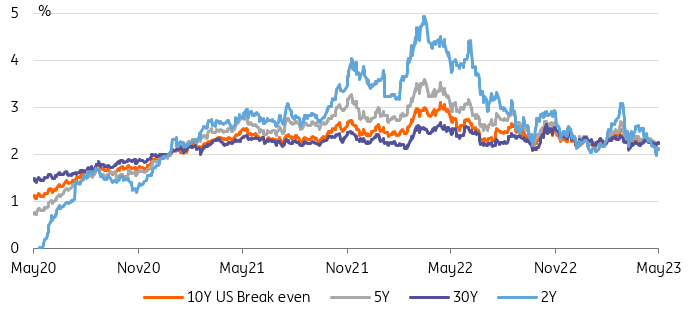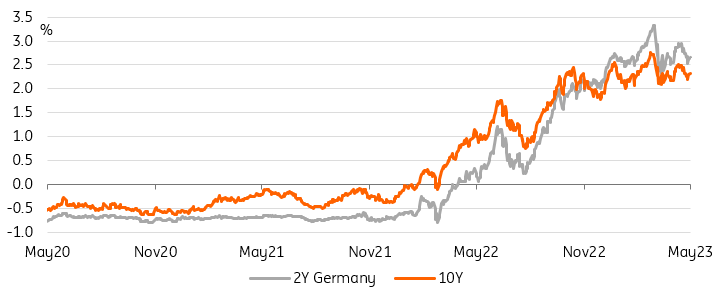By Benjamin Schroeder, Antoine Bouvet, Padhraic Garvey, CFA
Look for lower rates as risks to the outlook abound
The Fed has delivered its latest hike last week – in line with what markets currently price, and we largely agree. From here on, the market rates trend should be down as risks to the economic outlook abound and should eventually outweigh.
In the US, the failure to raise the debt ceiling poses a large risk to financial stability and the economy, and will likely come to dictate headlines in coming weeks. But think also of the simmering banking tensions and their knock-on effects, with the Senior Loan Officers Survey yesterday providing evidence of further credit tightening and thus compounding the recessionary risks coming from rapidly higher borrowing costs, as our economist notes. But keep in mind that when the Fed made its decision last week, it already had the survey at hand, and Fed Chair Powell noted it was broadly consistent with the FOMC’s thinking.
The Fed also released its latest financial stability report yesterday. The top of the list of most-cited risks was still occupied by persistent inflation and monetary tightening. Even if Wednesday’s CPI report could show the annual rate falling to below 5%, this still means inflation is running well above the Fed’s 2% target. And even if market-priced inflation forwards eventually point to the Fed coming close to its target a year from now, the NY Fed’s survey of consumer expectations saw inflation expectations at the medium and longer horizon increase slightly – three years ahead is now at 2.9% and five years ahead at 2.6%.
Rates actually inched further up yesterday, with 10Y UST reclaiming 3.5%. On this particular day, this was probably more due to a heavy slate of corporate debt issuance. But near term, our view of lower market rates by year-end does not exclude temporary moves higher. At this stage, direction is dictated by macro data and headlines surrounding banking tensions and the debt ceiling.
Even Upbeat Inflation Breakevens Suggest Returning To 2% Will Be A Struggle (Refinitiv, ING)
The ECB hawks will struggle to decouple from the US
In the Eurozone, money markets think the ECB can still deliver one, or at most two, hikes. But despite officials signalling that more ground needs to be covered, the market is not fully discounting 25bp at the June meeting. Arguably, the ECB returning to a 50bp increment looks very unlikely after last Thursday’s decision to hike at a slower pace. And markets probably don’t think that the ECB will be able to isolate itself entirely from the risks looming over the US outlook.
Chief economist Lane still highlighted that there “was a lot of momentum in inflation”, though forecasting “a lot of disinflation coming later this year.” Given the track record of forecasts, the focus will remain on the observable, with the ECB itself having flagged “significant upside risks” to the inflation outlook. But we doubt that the ECB’s hawks will be able to push market rates materially higher on their own, given that financial sentiment is largely dictated by developments in the US.
ECB Hawks Are Set To Attempt To Lift Euro Yields This Week (Refinitiv, ING)
Today’s events and market view
Main focus in the European session is on central bank speakers, where both ends of the ECB dove-hawk spectrum are represented today. Among others, Chief Economist Lane is representing the dovish end, while on the hawkish side, we will hear from Slovenia’s Vasle, Croatia’s Vujcic and, most prominently, from Isabel Schnabel, although only in the evening.
In the US, headlines surrounding the debt ceiling could dictate direction, with President Biden meeting with Speaker of the House McCarthy today. The data calendars have little of note aside from the US NFIB small business optimism index.
In primary markets, Austria will issue €1.7bn across 10Y and 20Y lines, while Germany reopens a 5Y bond. The European Union has mandated a dual tranche deal for a new 3Y bond and a 30Y tap, which should also be today’s business. The US Treasury will sell US$40bn in 3Y notes.
Content Disclaimer
This publication has been prepared by ING solely for information purposes irrespective of a particular user’s means, financial situation or investment objectives. The information does not constitute investment recommendation, and nor is it investment, legal or tax advice or an offer or solicitation to purchase or sell any financial instrument. Read more
Original Post
Editor’s Note: The summary bullets for this article were chosen by Seeking Alpha editors.
Read the full article here












